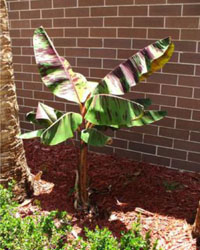Musa acuminata - Banana



Family Musaceae
Description:
About thirty-five to fifty species of wild bananas are native to Asia. The long tubular flowers of the wild species are reportedly pollinated by bats and sunbirds. The origin and taxonomy of many cultivated banana clones are confused by this plant's long association with people. Plants on campus may be selections of M. acuminata, M. balbisiana, or their hybrids. Cultivated bananas are important food plants around the world. Recent estimates place the annual world production around 80 million tons. The tender terminal of the flower stalk is eaten in some parts of the world. The leaves are used as a wrap for food and other uses, more or less as Americans use plastic bags or kitchen plastic wrap. Fibers from banana leaf stalks are used in weaving. Some selections are used as ornamental garden plants. Supermarket bananas are seedless but wild types contain hard seeds..Structurally, banana plants are not trees. The tall "stem" is composed of layers of leaf stalks and the true stem of the banana is underground.
Location:
See plants on the north side of building 39.
Size:
Herbaceous plant with leaves to four to twenty feet tall.
Care Instructions:
Light: full sun to part shade
Water: grows best with ample moisture
Soil: a rich, organic soil is best, plants respond well to fertilization
In north Florida, plants will die to the ground during cold winters and sprout again in spring. Banana fruit production is unreliable in northeast Florida due to the short growing season (compared to the tropics.)
